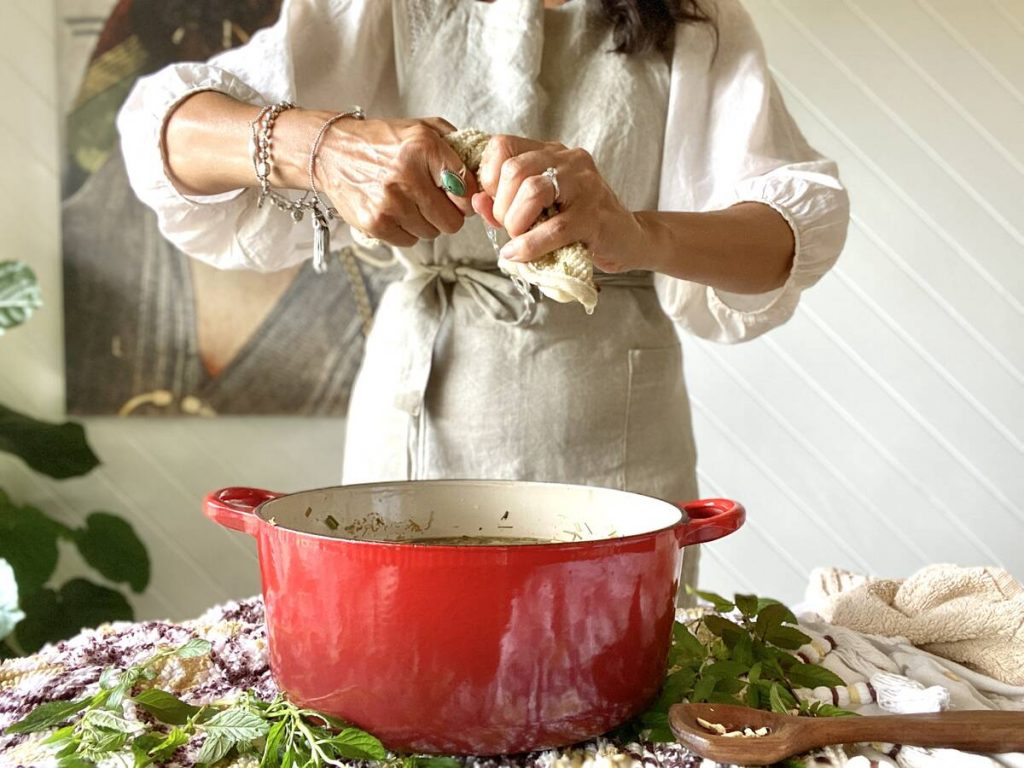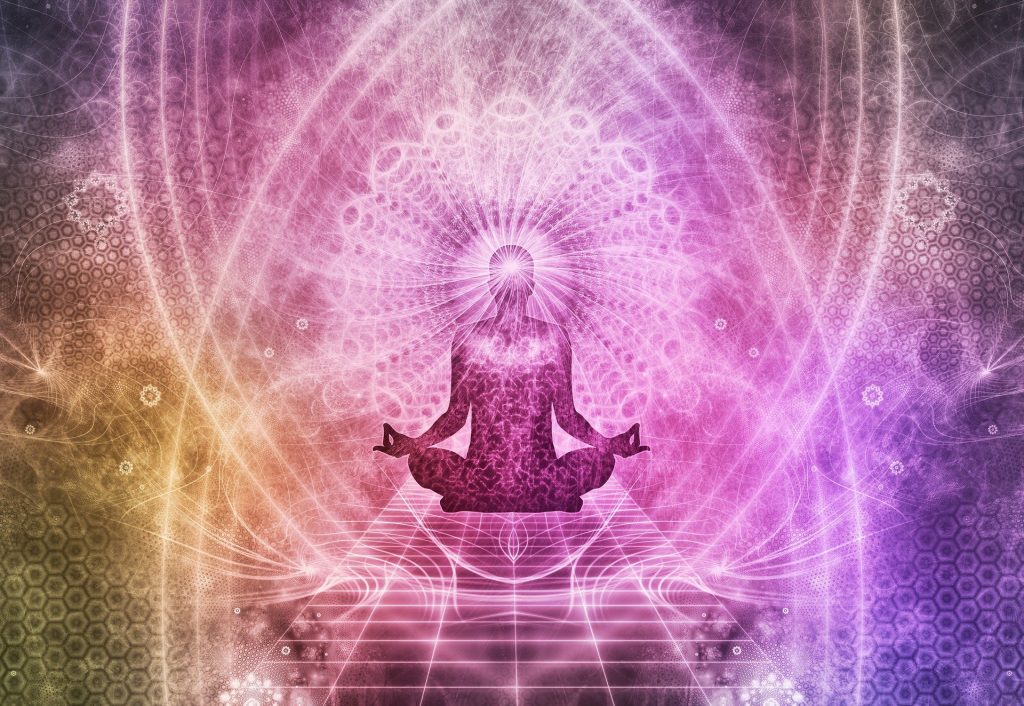Today we’re making one of the classic herbal treatments for muscular aches and pains, menstrual pain, joint inflammation, stiffness and general stagnation. You’ll learn about the uses of a hot herbal compress and the types of herbs that best suit this easy to make, topical preparation. We’ll look at both the western and eastern perspectives in terms of herbs and I’ll give you an intro in herbal energetics. You’ll also get my recipe for creating a compress to relieve muscle stiffness. Let’s dive into the world of the hot herbal compress!
What a Hot Compress is
The compress (also called a ‘fomentation’ when it covers a large part of the body) is a standard natural therapy used for a variety of conditions from headaches and skin diseases through to muscular aches and pains. What we’re making here is a hot compress, so by nature it has a warming effect on the area it’s applied to. Hot compresses are best suited to cold conditions characterised by stagnation, poor circulation and constriction. Some examples: arthritis, muscle stiffness, spasm, eye soreness. When applied, a hot compress does some really important things to get the healing process underway more quickly:
Boosts circulation, clearing blockages and congestion in the vascular system (we’re talking predominantly the blood circulation here but lymphatic congestion also benefits from warm applications). (4)
Attracts blood flow to the area where the compress is applied. This in turn delivers more nutrients to the area to facilitate healing and propels waste materials from the area at the same time. Ultimately this creates improved flow, which is why hot compresses are so useful where constriction and congestion manifest. (4)
Reduce spasm as a result of breaking up congestion and improving circulation. Spasm is after all, a reactive response to constriction or stagnation that results in a sudden release of blood flow, which can be uncomfortable and often painful. (4)
We’re not just relying on water for this treatment, we’re bringing in medicinal plants that work topically to bring warmth and heat to the area you’re treating, by creating a hot ‘herbal’ compress. These herbs are often aromatic (meaning, they’re rich in volatile oils) and pungent in flavour (a characteristic associated with spices). They have the ability to induce heat locally, which creates a local healing response. First let’s look at the concept of a ‘hot’ herb…
Hot & Cold is the most important aspect of herbal energetics
Traditional herbalism throughout the world considers warming, heating, cooling and other aspects of plant medicines when prescribing them, not just their phytochemical constituents and therapeutic actions. This is perhaps the most overlooked area in formal herbalism training in Australia and it’s called ‘Herbal Energetics’. What you’re looking at is the qualities of and the particular effect the plant has when ingested, something that many students struggle with because our learning is so theoretical these days. Students mostly learn about medicinal plants, their botanical properties, their scientific names, their actions and indications, without ever really tasting them or growing them.
Hot compresses use topical herbs with heating effects like Chilli and Cayenne, Ginger, Turmeric (beware of staining!), Prickly Ash and Brown Mustard. These tend to be hotter plants and should be avoided where skin is sensitive, inflamed or if there are allergies to the relevant plants. Also think about using medicinal resins like Frankincense and Myrrh which have heating and pungent natures but aren’t overly hot and stimulating. They do, however, have a strong affinity for inflammatory muscular conditions which is one of the main reasons that you would use a hot compress. Essential oils with heating effects can be useful in hot compresses as well, such as Eucalyptus, Nutmeg and our beloved (and incredibly smelly) Valerian. (3,8)
If you want something less fiery, warming plants will still get the blood flowing and relieve congestion and they can be applied for longer periods. They’re usually aromatic spices like Cinnamon, Clove, Fenugreek, Cardamom, Celery Seed and Black Pepper as opposed to aromatic culinary herbs like Sage which are more cooling. (3)
Ayurvedic herbs with heating effects topically include Nirgundi (Vitex negundo), Bakuchi (Psoralea corylifolia), Ashwagandha (Withania somnifera) and Asafoetida (Ferula asafoetida). (8)
You may also want a drying or astringent effect from the plants you use in your hot compress. This is most useful when you want to accelerate wound healing due to the tissue-tightening qualities of drying herbs. Another useful aspect of drying herbs is their ability to increase removal of pus, exudates and liquids from the skin when applied topically.
So now that you have some ideas of the plants you can use, let’s look at why you would prepare a hot herbal compress. As mentioned earlier, the idea of the hot compress is to break out congestion and boost circulation to a local area. Twenty-two common conditions that you can use a hot compress for are:
- Muscle spasm
- Muscle pain
- Muscle soreness
- Menstrual cramps
- Abdominal cramps
- Joint pain
- Osteoarthritis
- Joint swelling
- Sinus congestion
- To induce lactation in breastfeeding women
- Breast engorgement in lactating mothers (cold compresses are also useful here)
- Stagnant blood circulation
- As part of a detoxification protocol to flush toxins
- For muscle relaxation
- Eye swelling
- Eye redness
- Sore eyes
- Blepharitis
- Eye infections
- Stye
- Boils
- Cysts
What I love about compresses is they’re so easy to make. This recipe here is uses a decoction to extract the required chemicals from the plants, but you can easily make a compress using a simple 15 minute infusion so long as you’re just using soft plant parts like leaves and flowers. When using barks, seeds/fruits, stems and roots you really need to cook them for longer so the decoction is the most suitable preparation type.
Compresses are water-based, so they’re suitable for all types of skin apart from highly sensitive skin that may react to anything applied (think along the lines of eczema flareups and psoriasis here, or skin with recent burns). Being alcohol-free and preservative free you can use them on children and babies, and on delicate parts of the body like the eyes and face.
How to make a hot herbal compress
This compress is based on a decoction, where you simmer the plants in water for around 20 – 25 minutes, giving them plenty of time to impart their chemistry and qualities into the water. However you can also just use a standard herbal infusion where the herb is immersed in hot water for around 15 – 30 minutes. I prefer the decoction method for muscle stiffness, but for eye strain or infections, you might opt for an infusion instead. The level of penetration required is much less compared to muscular problems.
The main herb in this compress recipe is Ginger root (Zingiber officinale radix). Research reveals ginger has the ability to reduce muscle pain related to ‘eccentric’ exercise (!) within 24 hours. (1) It’s also effective at reducing painful breast engorgement in lactating women according to a 2021 study (14). A 2015 systematic review of the clinical effects of herbal compresses found significant benefits in painful and inflammatory conditions such as osteoarthritis, muscle pain and breast pain during lactation.(16)

{ .1. }
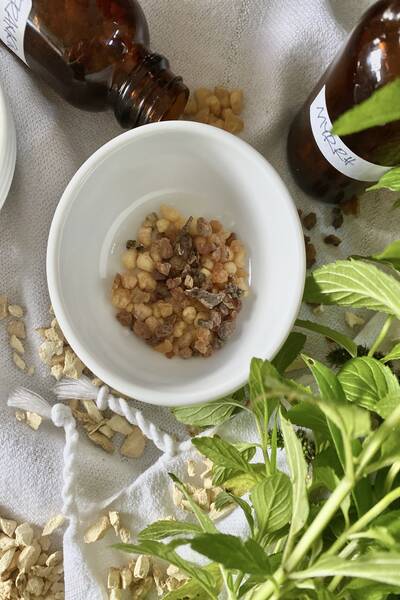
{ .2. }
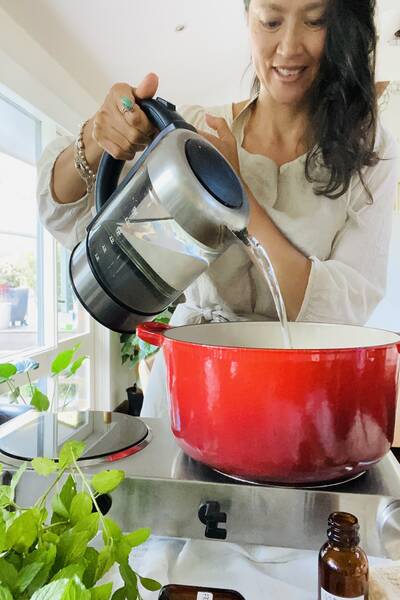
{ .3. }
Photos: Sulin Sze 2022
Ingredients
- Ginger 20g dried
- Peppermint 5 stems, around 15cm long each
- Lemongrass 6g
- Chamomile 3g
- Epsom salts 1 cup (I used Viriditas)
- Camphor (must have) used the Zen liniment gel 1 tbsp
- Myrrh 3g
- Frankincense 3g
- Eucalyptus essential oil 5 mL or 100 drops
Method
- Gather your root and bark herbs, fresh or dried, and place into a large pot filled with warm or hot water. I used 50g herbs (mostly dried, so the equivalent of 100g fresh herbs roughly) in this recipe, with around 2L water.
- Bring to the boil and simmer for 20 minutes or longer, or use a slow cooker if you prefer
- Remove the pot from heat and throw in any leaves and flowers. Cover and leave to sit for 30 minutes. You might like to strain this decoction now, and then return to a clean pot. Otherwise, it can get fairly messy (!)

{ .4. }
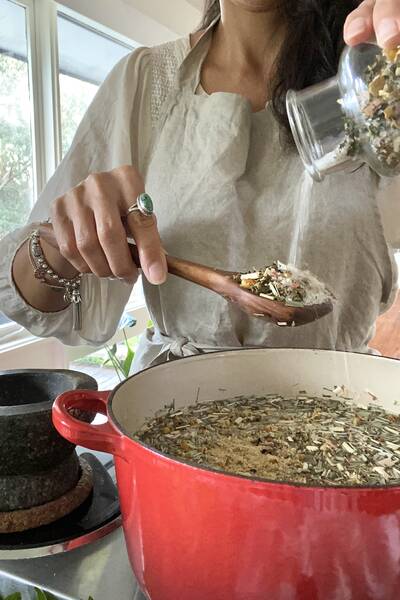
{ .5. }
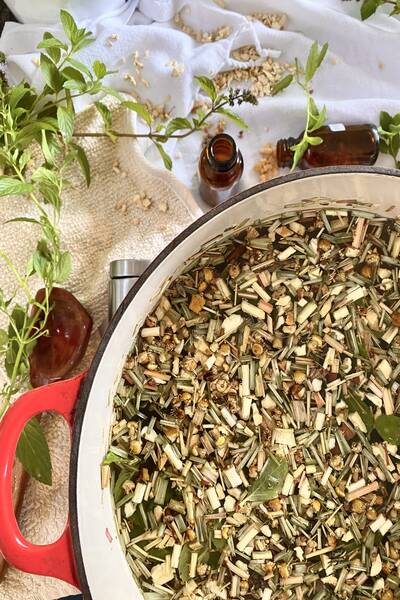
{ .6. }
Photo: Sulin Sze 2022
- Always test the temperature before using, so that you don’t burn yourself. When the temperature feels warm enough to feel pleasantly hot on the skin, dip a towel into the pot, and squeeze out firmly before applying to the skin for around 5 – 15 minutes. Check the skin is not becoming too red or reacting adversely to the compress. Be on the lookout for rash, raised skin, very red (scalded) skin or allergy appearance. If you have reactive skin, put a layer of material between the compress and your skin.
- The towel can then be removed and dipped in the herbal water again, and applied over and over again. I recommend repeating every 30 minutes. Discard the water after 24 hours. It’s likely to build up microbial and bacterial growth by that point.
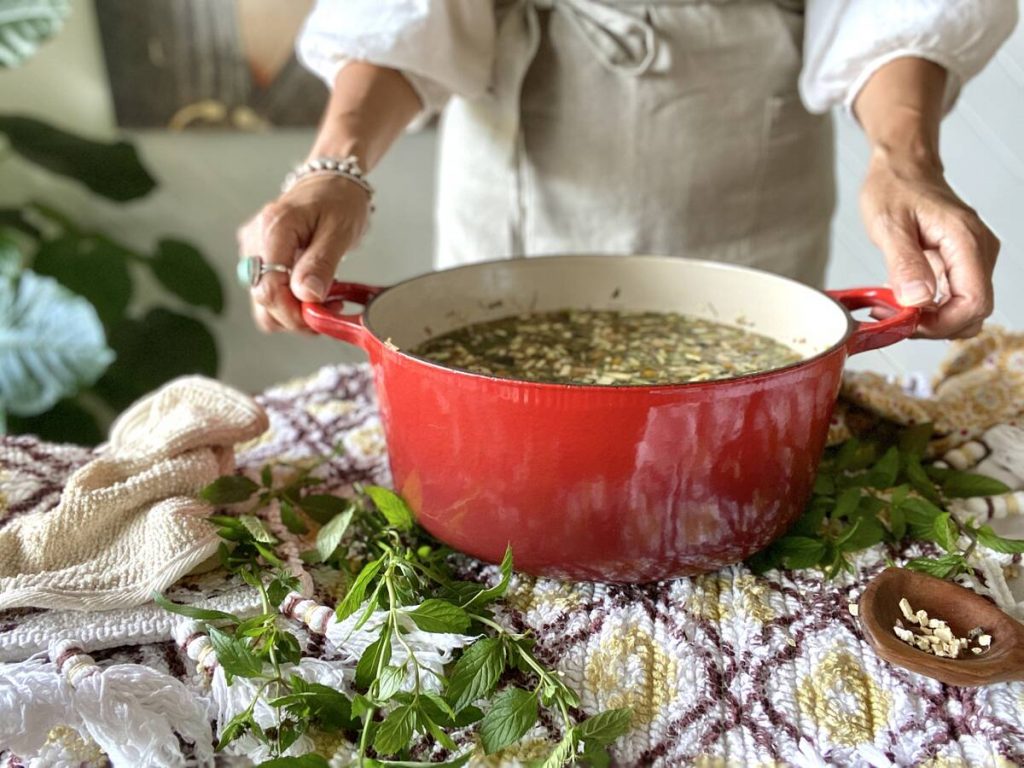
{ .7. }
Photo: Sulin Sze 2022
My favourite hot herbal compress recipes
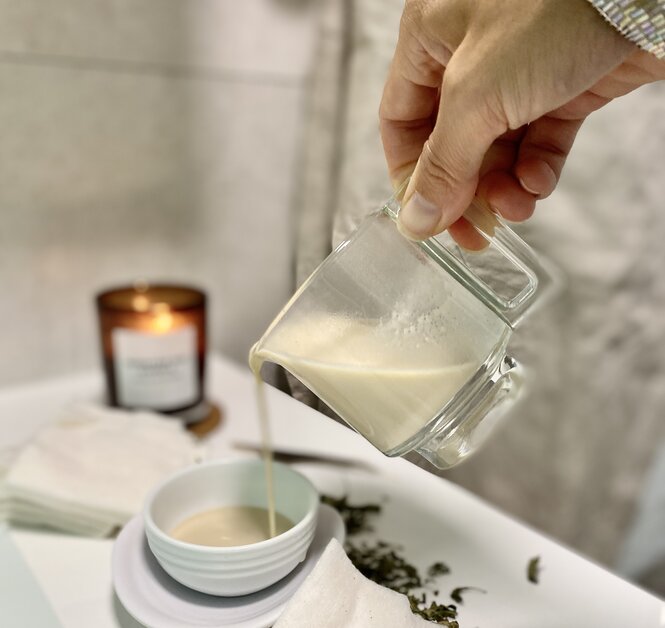
These are some of my favourite compress preparations that you might like try, I hope they inspire you!
- Cramp-busting hot herbal compress
- Soothing herbal compress for eye strain
- Nettle & Oat face and neck tightening compress
Have you got a recipe for a compress that you love? Share it in the comments below please and thankyou :)!
Photo: Nettle & Oat Compress by Sulin Sze 2022
Cramp-busting hot herbal compress
Applying a warm compress in period cramps (known as dysmenorrhoea) helps to relieve pain by enabling better blood flow through the abdomen and particularly in the uterus. I’d recommend using both internal medicines prescribed by a herbalist or naturopath, along with a compress. The herb you need here is Ginger (Zingiber officinale). It’s well regarded as an effective herb in period pain and this includes topical application. There isn’t a lot of scientific evidence for this application of Ginger, but it’s considered effective by many herbalists and this recipe draws more from traditional Chinese medicine which has a history of more than 2,000 years. Just saying!
Put the ginger in hot water in a small pot and simmer (as above) for around 20 minutes. Next, remove from heat and add the flowers. Leave to sit for 15 mins and it should cool a little. Strain and when the temperature is suitable, dip in a towel and apply to the abdominal area. Apply as often as needed.
Ingredients:
- Water
- 20g Ginger root (Zingiber officinale)
- 10g Jasmine flowers (Trachelospermum jasminoides)
- 10g Japanese Knotweed (Polygonum cuspidatum)
- 5 drops essential oil of German Chamomile (Matricaria chamomilla)
- 5 drops essential oil of Valerian (Valeriana officinalis)
- 3 drops essential oil of Lavender (Lavandula spp)
Soothing herbal compress for eye strain
You can use this compress for pretty much any eye conditions including soreness, bites around the eyes, allergies, dry eyes, tear gland issues, meibomiam gland issues (causing dry eyes), itchiness, conjunctivitis, eye strain, styes, blepharitis and swelling. Just be aware the skin in this area is very delicate so the temperature shouldn’t be hot, rather go for warm and check the skin is not irritated.
Prepare the herbs are a water infusion using hot water. Pop the herbs into a vessel, pour the water in to cover, and leave to infuse for 30 minutes, covered. Next, strain carefully (avoid bits of grit, aim for a smooth liquid extract), and then dip cotton wool pads into the warm extract and place over closed eyelids. Larger pads are great as they’ll cover the areas around the eyes as well. You could also use a face cloth if you like.
Ingredients:
- Water
- 4g Eyebright (Euphrasia officinalis)
- 4g Echinacea (Echinacea spp)
- 2g Fennel (Foeniculum vuglare)
- 2g Calendula (Calendula officinalis)
- 2g Lavender (Lavandula spp)
Wondering how to measure these out if you don’t have scales that measure in one gram increments? You might want to try using ratio proportions instead, so rather than looking at these as grams, look at them as ‘parts’: 5 parts Licorice, 5 parts Chamomile, 2.5 parts Lemongrass, 2.5 parts Gotu Kola. Next you could say if 1 part is 1 tsp, you can measure out accordingly, and just use around 2 Tbsp of all herbs when they’re combined to make up one batch. It’s not perfectly accurate, but approximate is fine when it comes to topical preparations.
Nettle and Oat face and neck tightening compress
For a more luxuriant take on compresses, you can use this formulation to nourish and tighten skin on the face and neck as well as increase natural glow. Like other compresses, it’s easy to make and also suits eczema and acne with the healing properties of Nettle and Oats. It’s fine to use it warm or cool, and whatever you don’t use in the first application can go in the fridge to better preserve it, before you use it again. Infusions like this don’t last longer than 24 hours though, so aim for a few applications throughout the day and then discard.
Combine the herbs, water, oil and milk in a small milk pan and put on medium heat. Gently warm (not boiling or simmering) for 20 minutes and then strain. Allow to cool a little before use.
Ingredients:
- 1 tsp Nettle leaf dried
- 1 Tbsp hot boiled water
- ¼ tsp coconut oil
- ¼ cup oat milk
I like to soak cotton wool pads in the extract and then gently wipe it over my face and neck, applying generously. Then I lie back with a meditation playing, and cover the areas of application with a warm and moist hand towel. But you can also dip a face cloth into the extract and dab it on. Dry skin may fare better with more frequent applications.
When NOT to use a hot compress
If you experience burning sensations, blistering or inflammation of the skin when using a hot compress, cease use. This could potentially lead to a first degree burn. Either the compress being used is too temperature hot, or the herbs are too strongly concentrated in the fluid.
Hot compresses induce circulation and promote heat in a local area and should be avoided in those with chronically poor circulation (instead, go warming rather than heating), heart disease, hypertension and pregnancy. Some joint or muscle injuries may fare better with cooling treatments.(5)
Summing up…
I hope you loved this article and that you’re excited to try out some compress recipes. This classic herbal preparation is so easy to make and as you can see, incredibly useful for a range of presentations. If this article piqued your interest, be sure to stay tuned for more. Happy herbal medicine making friends! Please do share your thoughts below and check out the blog for more articles.

Photo: Sulin Sze 2022
{ .8. }
Thanks for reading!
I hope you enjoyed this read. Go ahead and pop a comment or share some tips of your own in the comment box below. We love hearing from our readers.
Don’t forget we’ve got some great medicine making courses on the Wild Medicine Academy here, including the 16 unit ELIXIRS program which is perfect if you want to learn everything about herbs and making medicines with them.
If you enjoyed this article, you’ll love our Art of the Infusion webinar with lots of recipes and tips on herbs to use in water based preparations.
To cite this article: Sze, S (2022, February 7). How to make a hot herbal compress. Wild Medicine Academy. https://wildmedicineacademy.com/?p=6012
References
- Black, C. D., Herring, M. P., Hurley, D. J., & O’Connor, P. J. (2010). Ginger (Zingiber officinale) reduces muscle pain caused by eccentric exercise. The journal of pain, 11(9), 894-903.
- Thanki, K., Bhatt, N., & Shukla, V. D. (2012). Effect of kshara basti and nirgundi ghana vati on amavata (rheumatoid arthritis). Ayu, 33(1), 50.
- Kress, H. (2018). Practical herbs 2. Aeon Books.
- Adams, J and Tan, E (2011) Herbal manufacturing – How to makes medicines from plants. 2nd edn. Northern Melbourne Institute of TAFE, Preston, Australia.
- Raghuram, Y.S, Manasa B. (n.d) Hot Compression Therapy Types, Procedure, Benefits, Precautions. [web article] Easy Ayurveda. Accessed 3rd February 2022: https://www.easyayurveda.com/2018/06/19/hot-compression-therapy/amp/
- Easley, T., & Horne, S. H. (2016). The modern herbal dispensatory : a medicine-making guide. North Atlantic Books.
- Green, J. (2000). The herbal medicine-makers’ handbook : a home manual. Crossing Press.
- Dass, V. (2013). Ayurvedic Herbology – East and West. Lotus Press. USA
- Mashhadi, N. S., Ghiasvand, R., Askari, G., Hariri, M., Darvishi, L., & Mofid, M. R. (2013). Anti-oxidative and anti-inflammatory effects of ginger in health and physical activity: review of current evidence. International journal of preventive medicine, 4(Suppl 1), S36.
- Rahnama, P., Montazeri, A., Huseini, H. F., Kianbakht, S., & Naseri, M. (2012). Effect of Zingiber officinale R. rhizomes (ginger) on pain relief in primary dysmenorrhea: a placebo randomized trial. BMC complementary and alternative medicine, 12(1), 1-7.
- Waring, R. H. (2010). Report on Absorption of magnesium sulfate (Epsom salts) across the skin. School of Biosciences, University of Birmingham, B15 2TT, UK.
- Leung, P. C., Ko, E. C. H., Siu, W. S., Pang, E. S. Y., & Lau, C. B. S. (2016). Selected topical agents used in traditional Chinese medicine in the treatment of minor injuries-a review. Frontiers in Pharmacology, 7, 16.
- Boonruab, J., Damjuti, W., Niempoog, S., & Pattaraarchachai, J. (2019). Effectiveness of hot herbal compress versus topical diclofenac in treating patients with myofascial pain syndrome. Journal of Traditional and Complementary Medicine, 9(2), 163-167.
- Monazzami, M., Yousefzadeh, S., Rakhshandeh, H., & Esmaily, H. (2021). Comparing the effects of hot compress and hot ginger compress on pain associated with breast engorgement. Nursing and Midwifery Studies, 10(2), 73-78.
- dos-Santos, G. K. A., & Alfieri, F. M. (2020). Effects of cold versus hot compress on pain in university students with primary dysmenorrhea. BrJP, 3, 25-28.
- Dhippayom, T., Kongkaew, C., Chaiyakunapruk, N., Dilokthornsakul, P., Sruamsiri, R., Saokaew, S., & Chuthaputti, A. (2015). Clinical effects of Thai herbal compress: a systematic review and meta-analysis. Evidence-Based Complementary and Alternative Medicine, 2015.
- Cheung, L. K., Osei-Kuffour, D., & Drake, P. J. (2021). Full thickness burn after Thai herbal hot compress massage ball therapy. Burns Open, 5(2), 78-80.
- Lindsley, K., Matsumura, S., Hatef, E., & Akpek, E. K. (2012). Interventions for chronic blepharitis. Cochrane Database of Systematic Reviews, (5).
- White, A. (2018). How to use a warm eye compress to treat stye and other conditions. Healthline [website]. Available at: https://www.healthline.com/health/warm-compress-for-eye

